Renewed interest in my research into the 1934–1935 tour by the Dandré-Levitoff Russian Ballet has prompted me to post further material that originally appeared as appendices to my article on the tours. The article appeared in Dance Research (Edinburgh University Press), 29:1 Summer 2011.
Below is a list of divertissements that were performed in Australia, Appendix B of the Dance Research article. In a previous post I listed the repertoire and schedule of performances (Appendix A of the Dance Research article) but listed only the title ‘Divertissements’, where appropriate, without giving details.
APPENDIX B: AUSTRALIAN DIVERTISSEMENTS
This list of divertissements, the short pieces that usually concluded each program, has been constructed from programs for Australian seasons in Brisbane, Sydney, Melbourne and Perth. Occasionally alternative names were used and they have been included preceded by a slash. Occasionally, too, Promenade (Old Vienna) and Polovtsian Dances were listed in advertisements as divertissements rather than as main program items. They have not been included on this list and have been kept as part of the main repertoire schedule. The list may not be complete and other divertissements may have been in included outside Australia.
| Abhinaya nrita (Authentic Hindu music/Hindu melody) Bluebird (Tschaikowsky) Dance of the doll (Kiurci) Dance of the doll (Salvado) Dance of the hours (Ponchielli) Danse russe/Russian dance (Bakalienikoff) Etude plastique (Liszt) Grand pas classique (Deldevez) (Grand) pas hongrois classique (Glazounoff) Guitana/La gitana (Salvado) Ice maiden (Grieg) Indian tribal dance (Minkus) Japanese dances (Original Japanese music) L’oiseau (Schumann) Magyar tanc/dance (Bartok) Mexican dance (Padilla) | Negro fire-worship dance (Stempinsky) Nocturn (Schumann) Pas de fleurs (Tschaikowsky) Pizzicato (Gillet) Spanish character dance (Romero) Spanish dance (Albeniz) Spanish dance (Granados) Tarantella (Rossini) The faun (Debussy) The love song (Kreisler) Toreador Spanish dance (Julio Garson) Trepak (Launitz) Valse (Fetras) Valse (Strauss) Valse brilliante (Chopin) Voices of spring (Strauss) |
***********************************
Below is a list of dancers who performed during the Australian leg of the tour, Appendix C of the Dance Research article.
APPENDIX C: DANCERS PERFORMING IN AUSTRALIA
Press reports on the arrival of the company in Australia noted that it comprised 36 dancers. (‘The Russian Ballet arrival in Sydney’, The Sydney Morning Herald, 26 October 1934, p. 12). Listed below, with some explanatory notes, are those whose names I have found appearing on programs or mentioned in the press, adding up to less than 36 dancers.
Women:
Olga Spessiva (Brisbane and Sydney) and Natasha Bojkovich with
Kathleen Crofton, Lisa Elem, Juliana Enakieff, Tamara Djakelly (Giakelly), Eileen Keegan, Raia Kuznetzova, Molly Lake, Eleanora Marra, Lola Michel,* Anna Northcote, Elvira Rone, Christine Rosslyn, Vera Sevna, Edna Tresahar,** Audrey Valeska.
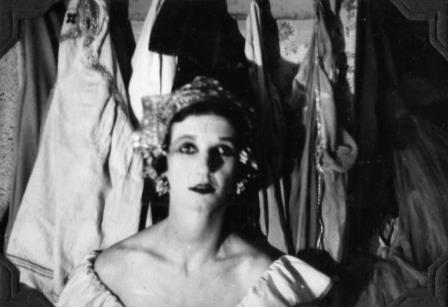
Men:
Anatole Vilzak, Stanley Judson, Paul (Pavel) Petroff, H. Algeranoff and Dimitri Rostoff with Jan Kowsky (Leon Kellaway), Travis Kemp, Slava Toumine, A. Piekers, George Zorich.***
* The name Lisa Mitchell is mentioned in a review (‘Ballets of beauty’, Courier Mail (Brisbane), 15 October 1934, p. 21) but not in cast lists in programs. I have assumed the review is a misspelling of Lola Michel, a name that does appear in cast lists and reviews.
** The Sydney Morning Herald mentions an Edna Tresabel (‘The Russian Ballet. Arrival in Sydney. Olga Spessiva and her company’. The Sydney Morning Herald, 26 October 1934, p. 12). I have not been able to find another reference to Tresabel and have assumed it to be a misspelling of Edna Tresahar.
***George Zorich spelled his second name Zoritch in his memoirs. It was always Zorich in programs for this company.
The following dancers are listed in various South African newspaper sources but did not appear in Australia in 1934–1935: Vera Nemchinova, Anatole Oboukhoff, L. Kutchurovsky (Katshrovsky), Nicolai Zvereff. Marina Grut also mentions that Nana Gollner and Yvonne Blake performed in South Africa (Selma Jeanne Cohen (ed), International Encylopedia of Dance (New York: Oxford University Press, 1998), Vol. 5, p. 650.
A photo of Otto Kruger appears in Brisbane programs but this name never appears in cast lists in the programs.
***********************************
The material contained in these appendices should not be considered as necessarily complete or definitive at this stage. Any additions or corrections, preferably with sources cited, are welcome. Other online material about the tour is at this tag: Dandré-Levitoff Russian Ballet.
All textual material contained in these appendices and in the article is the intellectual property of The Society for Dance Research and should not be reproduced without permission. Full bibliographic details.
Michelle Potter, 23 September 2013
Featured image: Finale, Les Sylphides, Dandré-Levitoff Russian Ballet, ca. 1934. Personal archive of Anna Northcote, private collection
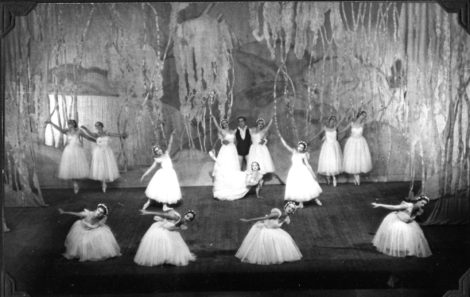
The image below is labelled ‘Lisa … Carnival’ in Anna Northcote’s photo album. It is possibly the Lisa Mitchell/Lola Michel/Lisa Mulchelkans/Elisa Mutschelkmans mentioned in the list of dancers above and in the comment from David Sumray below.
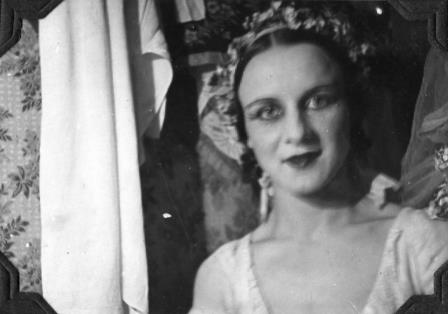
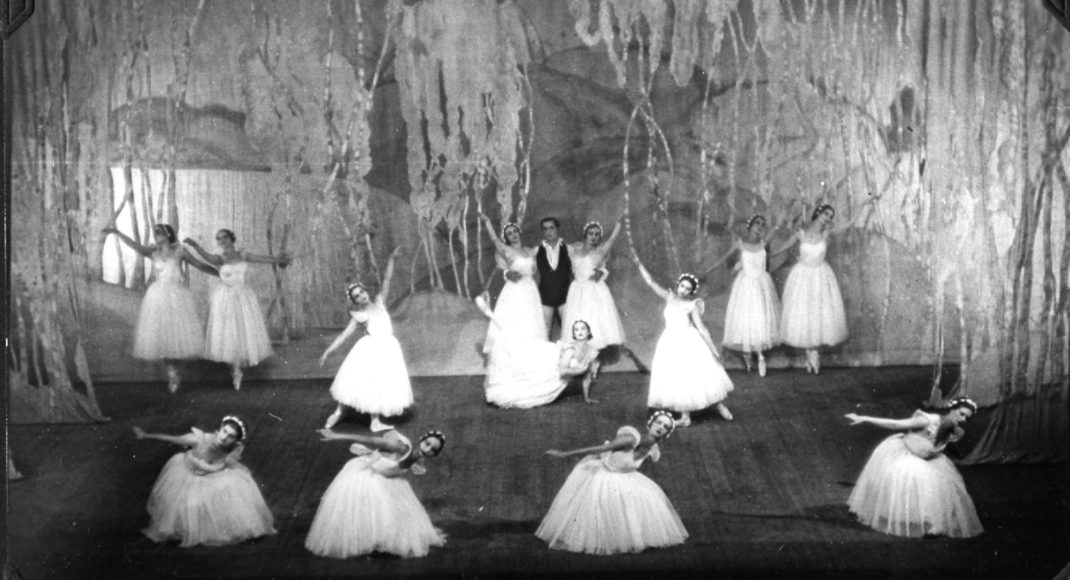
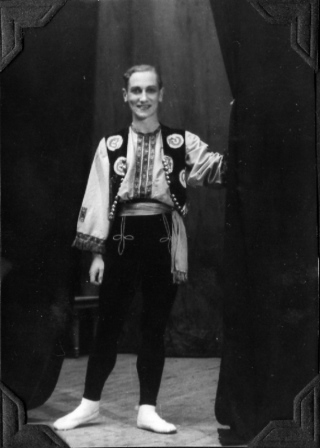
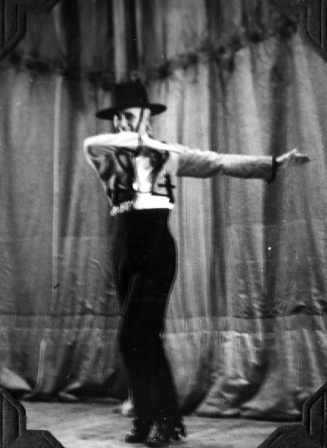
I believe that the Lisa Mitchell/Lola Michel question may be a rare example of a ballet dancer’s name being anglicised. Amongst the names of the Dandre-Levitoff Company sailing to South Africa on ‘Kenilworth Castle’ on 27 April 1934, there is one ‘Lisa Mulchelkans’. The Manifest of the ‘Moreton Bay’ for the return journey to England in May 1935 lists ‘Elisa Mutschelkmans’. It’s possible that the correct spelling is ‘Mutchelknaus’.
Thank you for this comment David. A bit more searching, this time on the website of the National Archives of Australia, indicates that Elisa Mutschelknaus, born in 1906 of Argentinian nationality, arrived in Brisbane on the NIEUW HOLLAND on 8 October 1934. As these details would have been transcribed from the immigration document completed by the dancer, and barring any errors in transcription, we most likely have the birth name of the dancer who performed in Australia as Lola Michel (according to many programs) and who is occasionally called Lisa Mitchell in newspaper reports in Australia. Mutschelknaus does not sound very Argentinian, however, so any other information you may have come across would be gratefully received.
And one further note: I have just noticed on a ship’s passenger list issued on board the Nieuw Holland on the journey to Brisbane the name ‘Miss E. Mitschelknousse’, which I must previously have dismissed as a non-dancing passenger!
‘Mutchelknaus’ (and variations) appears to be a German name. Germany and Argentina have a long history of diplomatic and economic rapport, going back to the 1830s, and many Germans emigrated to the Argentine in the late 19th Century. Argentinians of German descent form a significant part of the population.
Regarding the repertoire of divertissements: these are, to me, very interesting in terms of those items which were recycled from the repertoire of the Pavlova Company, but I find ‘The Indian Tribal Dance’ music by Minkus tantalising in its possibilities. Without knowing more than the title and the composer, I am wondering whether it is possible that this may have been something from ‘La Bayadere’. If so, then it may have been the Dandre-Levitoff Company which was the first to present any part of this ballet outside of Russia (the first known Western presentation of the ballet itself was a revival by Feodorova in Rio de Janeiro in early 1961, followed by a performance by the Kirov at the Palais Garnier later that year). There is an earlier connnection between Bayadere and Dandre: in 1927, Pavlova considered reviving the ballet, and brought Nicholai Sergieff from Paris to mount it for her. According to Algeranoff (his 1956 memoir), all was going reasonably well until Sergieff started rehearsing Aubrey Hitchins and John Sergieff in the Fakir’s Dance and then ‘It was so demode that the Company were having hysterics ….. Pavlova saw it, and then she realised that it was no good trying to revive this old monstrosity which had once been so good in Russia; the Fakir’s dance settled it’. I don’t know whether the programme gives any further information, e.g. who was dancing it, but I think it’s worth looking into, especially as you, Michelle, may be able to re-write some ballet history.
In case this information helps with identifying dancers on the tour, from the Manifest of the ‘Kenilworth Castle’, from Southampton to South Africa on 27 April 1934 (all First Class), and reproducing the spelling: Eugene and Nathalie Arciuk; Mrs Natasha Boshkovitch; Mr Alexandre Kitchine; Mrs Raissa Kouznetsova-Hirsch; Mr Dmitri Kulcizky; Mr Otto Kruger; Mr Alexandre Levitoff; Miss Lisa Mulschelkans; Mrs Vera Zviereff Nemtchinova; Mr Anatole Oboukchoff; Mr Paul Petroff; Mr Arturs Pikiers; Miss Juliana Ianakieva; Mr Sviatrokay Toumine; Miss T. Djakelli; Miss E.V. Evans (Vera Sevna): Mr S. Judson; Miss E. Keegan; Miss M. King (Mary King); Mr J.T. Kemp (Travis Kemp); Miss C. Powell; Miss E. Phillips (Eleanor Marra Morgan Phillips – full name being given on the Manifest of the ‘Ile de France’, sailing from Le Havre to New York on 21 August 1935); Miss E. Rone (alhough there is a line through this name, which would normally indicate she didn’t travel, but I have not been able to find that she sailed so South Africa separately). As mentioned earlier, Juliana Ianakieva’s mother travelled Third Class. I’ve not been able to find details for any back-stage staff.
Edna Tresahar, Kathleen Crofton and Harcourt Essex (Algeranoff) did not join the tour until much later: they sailed from Southampton to Batavia on 17 August 1934, travelling, Second Class, on the ‘Christian Huygens’
David, your recent comments bring up many interesting points, indicating of course that research is never finished! I was pleased to have your list of passengers leaving on the Kenilworth Castle, which is slightly different from the arriving passenger list I came across when writing the Dance Research article. The Cape Times lists Elvira Rone as one of the passengers for example. But apart from anything else the mysterious A. Piekers from Australian programs now has a first name! Re the Arciuk (also spelt Archiuk) couple, Natalie/Nathalie was the company wardrobe mistress and Eugene the stage director. That they travelled first class (apart from poor Mrs Enakieva in steerage) is also interesting because Anna Northcote’s contract, which was signed by Levitoff and dated 3 April 1934, stipulates second class ship and third class train.
With my list of divertissements, it was compiled from programs, which only ever gave name of work, composer (often with an unusual spelling) and name of performer or performers. As I indicated too, it was only a list of diverts performed in Australia. I did not, for the Dance Research article, look at the diverts that were performed elsewhere. Now comes the interesting bit as far as Bayadere is concerned. In my possession I have a few programs from South Africa and Java. In some of these programs a divert called variously La Bayadere, Bajadera, Dance from the ballet “Bajadera” is listed. Mostly the music is attributed to Minkus, except in Cape Town where one program has no composer mentioned and another has Puni (sic). In South Africa and Java the solo was always danced by Raia Kouznetsova. Here is a brief mention of the dance from an unidentified South African newspaper (from Johannesburg I think). It is the only mention I have been able to find at this stage:
Raia Kouznetzova’s voluptuous solo from the ballet “Bajadera” struck a new note.
So, as you suggest David, this solo does bear further investigation. It’s relationship with the Australian Indian tribal dance is unclear at the moment but it does suggest that the rehearsals for Bayadere that Algeranoff mentions in his book may have led to the inclusion of this solo in the Dandre-Levitoff touring program.
At a Sotheby’s [London] auction on July 16, 1968, item 310 was offered as follows : La Danse De La Bayadere. It comprised a manuscript full orchestral score of 17 pages and a manuscript piano arrangement. There was also a manuscript set of orchestral parts. Frustratingly, no composer was given in the catalogue listing. This item was listed as having been consigned by the trustees of the “Diaghilev and De Basil Ballets Foundation Ltd.” During a number of these auctions a lot of orchestral materials were sold, many coming from Pavlova’s repertoire and generally credited with having been consigned from the Diaghilev and De Basil Foundation. Presumably when Dandre became involved with the De Basil enterprise this material became part of De Basil’s possible repertoire.
Re. Indian Tribal Dance: again, going only on the composer and assuming La Bayadere, the one that springs to mind from Bayadere that might fit with that title would be the drum dance. Hopefully, one of the Australian programmes lists how many performers took part.
In passing, I have found shipping records (immigration records) for the Arciuks arriving in Argentina in September 1929, which I mention only in connection with Lisa Mutchelknaus.
It seems as though the dance ‘La Bayadere’ was performed in Australia, though perhaps not very often. Review from The Daily News (Perth) of 15 January 1935: ‘Bakalienikoff’s La Bayadere by Mlle. Kouznetsova, pure oriental work of the nautsch or temple dancer.’ From same paper, following day: ‘……. Mlle. Kuznetsova’s artifically bronzed body and barbaric jewellery in La Bayadere.’ From The Sunday Times, Perth, on 20 January 1935, an article by ‘Renee’ on the ballet frocking: ‘For La Bayadere, Mlle, Kuznetsova was a glittering figure in silver sequins’.
It will be a few days before I can get to the program collection to check who is credited (composer and performer(s)) for the Australian Indian tribal dance. I am surprised that from the Perth reviews that David found that the composer is not Minkus but time will tell I guess. It sounds like it was a ‘Kuznetsova special’ though.
With regard to Bakalienikoff, just a thought that he may have been choreographer rather than composer: In Mikhail Mordkin’s company – per the programme of its appearance in Pittsburgh in 1926 – there was a ‘Vladimir Bakaleinikoff’ listed amongst the dancers for ‘Aziade’.
Re. my previous post – it’ll teach me to double-check before I belt into print, because Bakaleinikoff was the conductor – so sorry.
In any case, the choreographer was not mentioned (not that I have found anyway) for divertissements.
About La Bayadere: One Andre Schaikev- itch wrote an eulogistic biography of Olga Spessivtzeva in French, publication date 1954. On page 80 there is a very brief account of a revival of Act III of La Bayadere, evidently (my French is not good) to have been performed at a grand fete in Morocco, circa 1923. A photo shows the ballerina supported by S(Serge?) Peretti in a “Glyndebourne” hat, with a semicircle of 8 maidens,draped in rather 1920’s caps and veils. This may well be the earliest “Bayaderka” west of Russia.
Judith Judson’s post is very interesting – I was given a copy of Nina Tikanova’s autobiography ‘La Jeune Fille en Bleu’ for Christmas (in French, which I can only read very slowly, and with a dictionary). Tikanova writes of this performance of ‘Acte des Ombres de la Bayadere’, but doesn’t date it. It was a gala given by the Cercle Interallie in honour of the Sultan of Morocco. There is a photograph of Spessiva, Peretti (yes, Serge is correct) and the Shades – Spessiva and Peretti wear the standard headbands with the upright feathers at front. I’ll post any further relevant information once I’ve translated it. I was further prompted by Ms Judson’s to do some more checking, and I see from the NY Metropolitan Ballet website that that ‘Le Reve du Radjah’ from Act IV was presented by the ‘Russian Ballet’ (no further indication which one, and I can’t see any indication that this was in the repertoire of the Ballets Russes de Monte Carlo so perhaps Dandre-Levitoff pre-Australia?) at the Bournemouth Pavilion (UK) on 5 March 1934.
Re. Andre Shaikevitch – I was doing a bit of searching on him, and found the programme for ‘Colonel de Basil’s Monte Carlo Russian Ballet’ at the Theatre Royal Adelaide on 7th and 8th July 1937; Shaikevitch wrote the libretto for ‘Port Said’. Elsewhere, I have found him described as a ‘Russian-French critic’.
I know I am getting to be like a bad case of hiccups – all fits and starts, so apologies to you, Michelle, and your other followers. Reading some more of Tikanova’s autobiography (should have started at the beginning, really): firstly, Tikanova was Andre Schaikevitch’s half-sister; secondly, going on what Tikanova wrote about her tours with Boris Romanov’s Romantic Russian Ballet, it looked as though the Gala at which The Shades scene was danced was later than 1923. The Sultan of Morocco visited France in July 1926, he inaugurated the Paris Mosque, lots of ceremonies, including a gala of Romeo and Juliet at the Opera on 24 July – I can’t, so far, date the ballet gala exactly, but ‘Comoedia’ of 30 July 1926 reports ‘Un Gala de la Danse au Cercle Interallie – La Bayadere de Marius Petipa – un Adage de Mlle Spessitseva.’
However, it looks as though Paris was beaten to it by the Riga Opera Ballet, which presented Act IV at Riga in 1923 (per the NY Metropolitan Ballet website), and as Latvia was a republic by then, I guess Riga gets the palm for the first presentation outside of Russia.
Re. Raissa Kouznetsova(Polish spelling Kuzniecowa)in 1927 married Polish dancer Walery Szajewski. Why did she travelled with Dandre-Levitoff Ballet under the name of Kouznetsova Hirsch?. Walery arrived to Adelaide by “Moldova” on 10 Oct 1936 and performed there with Colonel W.de Bassil’s “Monte Carlo Ballet”.Raissa and Walery lived in Australia till 1958 or 1959,than returned to Poland to take top positions in The Polish National Opera and Theatre,Warsaw.They died there 1994 an 1995, respectively.
Please see some comments at this link.
Re.Raissa and Valery. I found information about their wedding on http://www.sejm-wielki.pl/n/szajewski website.I know relevant records kept at NAA,what a mystery, she gave three different nationalities:Russian, German, Austrian!I also found this notice,”The SMH”, Wed,13 May 1953,p.28:”I,Raissa Szajewski, of Polish nationality, born at Moscow,Russia,resident 14 yrs in Australia,now residing 15A Bridge St,Sydney, intend to apply for naturalisation under N&C Act 1948-1950″.By the way, I live in Wollongong.
How absolutely fascinating! Her naturalisation records may be at the NAA. If so they may contain all kinds of other information. I was amazed at what I found when I looked, for example, at the naturalisation records of Valentin Zeglovsky.
We still are none the wiser about the Hirsch name, but what you have uncovered suggests that Raissa was quite good at writing different things about herself.
Thank you for posting your comments. You have really opened up the story. And I have added a bit to my other post noting that the comment didn’t come from Poland!!
In the mid 1940’s I attended ballet classes in Bridge Street run by Raissa Kousnetsova (Polish Australian Ballet.)
Do you have a particular recollection of those classes?
My wife’s great Uncle was Stanley Judson and we have some video footage of the first international tour, some photos and Stanley’s diaries and his touring case as well as many other items. We just went to the opening of the Nutcracker, where Stanley played the Prince in 1934. We would like to know more about him if possible.
Thank you for contacting me. I’ll look back through various items I have and sources that might be useful and get back to you in due course.